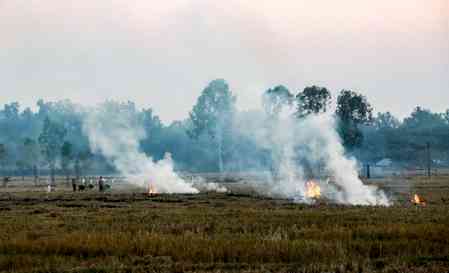Tiger population in Bengal's Sunderbans expected to go up to 150
West Bengal Forest Minister Jyotipriyo Mullick was euphoric as he claimed that the tiger population in the Sunderbans mangrove forests scattered mainly over South 24 Parganas and partially over North 24 Parganas districts in the state is slated to witness a significant rise after the latest census report on this count comes.

Kolkata, April 8 (IANS) West Bengal Forest Minister Jyotipriyo Mullick was euphoric as he claimed that the tiger population in the Sunderbans mangrove forests scattered mainly over South 24 Parganas and partially over North 24 Parganas districts in the state is slated to witness a significant rise after the latest census report on this count comes.
According to him, as per the estimates of his department based on the footage of camera-traps laid for the census, the current number of Royal Bengal Tigers in the Sunderbans is expected to be around 150.
"Although the final figure will be arrived at after the final figure is announced by the Union government, the experts of the forest department are quite certain that the figure will hover around 150," Mullick claimed.
According to him, the projected figure is substantially higher than the figure of 112 revealed in the last census in 2018. "This year the country is celebrating the 50th year of the launch of Project Tiger in April 1973. Sunderbans in West Bengal is an example of the success story on this count," he said.
The findings of the latest tiger census show the success of Project Tiger. The 2018 census showed the number of tigers in the country at 2,967 from just 1,411 in 2006.
According to Mullick, the success of the Sunderbans model is a part of the success of Project Tiger nationally. Sunderbans is one of the 17 tiger reserves in the country which have got CA|TS international accreditation.
He added that the state government intends to make more areas in the Sunderbans as "core tiger zones" to provide a wider movement area for the tigers. The process of identification of the forest areas for that purpose has already started.
Besides taking a positive approach towards increasing the area for the "core tiger zone," the forest department is also ensuring that the tigers in the Sunderbans do not run short of their natural food.
For that purpose, last month the forest department had acquired around 100 deer from different sanctuaries in the country.
These deer have been kept in a safe area within the tiger zone and according to the forest department officials once these deer get acclimatised to the ambience of this mangrove forest zone they would be released in the core areas,
According to the deputy director of the Sunderbans Tiger Reserve, Jones Justin these deer had been specially brought as food for the tigers. "We are ensuring that the tigers do not run short of their staple food," he said.
According to him, the Royal Bengal Tiger not only puts the Sunderbans but also the entire West Bengal in the global recognition map. "The state forest department constantly innovates towards making the mangrove forests of Sunderbans an ideal forest abode for the tigers. This will make these mangrove forests a safe haven for the tigers, which will ultimately result in an increase in the tiger population here," he said.
Meanwhile, the forest department has launched an initiative to develop Buxa Tiger Reserve in Alipurduar district in north Bengal to make it an ideal abode for the Royal Bengal Tigers.
The plan is to bring a couple of tigers from adjacent Assam and release them at the Buxa Tiger Reserve to increase the tiger population there. Although, consent has been received from the Assam government for the tigers, the West Bengal government will take some time before finally taking steps towards this.
According to Buxa Tiger Reserve field director Apurba Sen, the first step will be to make the tiger reserve an ideal abode for the Royal Bengal Tigers especially with regard to availability of their staple food. For that purpose, recently 86 spotted deer have been brought from Ballavpur sanctuary in Birbhum district and released in the Reserve.
According to Sen, although the Reserve has enough sambar and barking deer, the spotted deer are the favourite as diet for the Royal Bengal Tigers, "Our first idea is to make arrangements for enough food for the tigers in the region so that they will not have to move elsewhere in search of food. If necessary, more spotted deer will be released in the reserve zone," he added.


 IANS
IANS 











